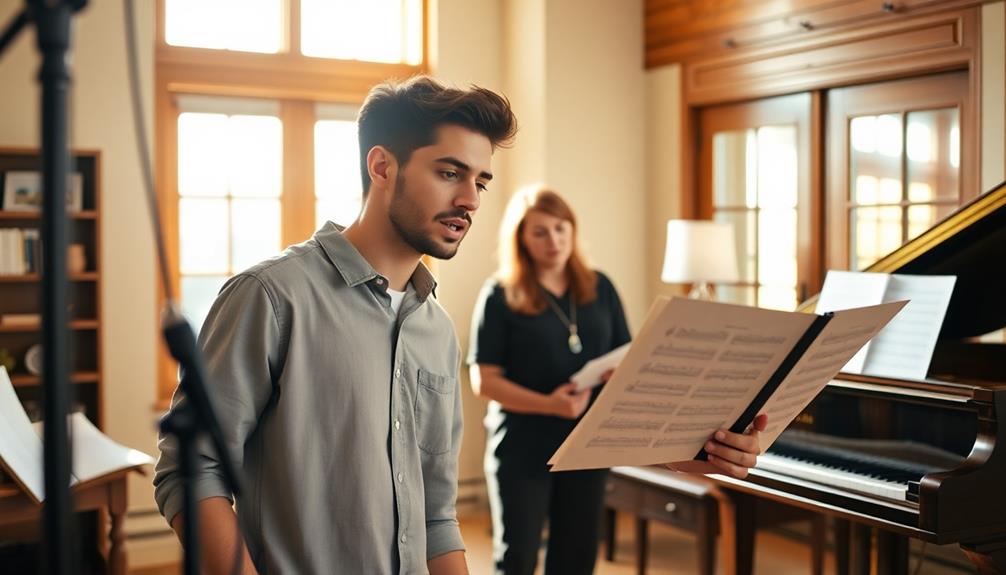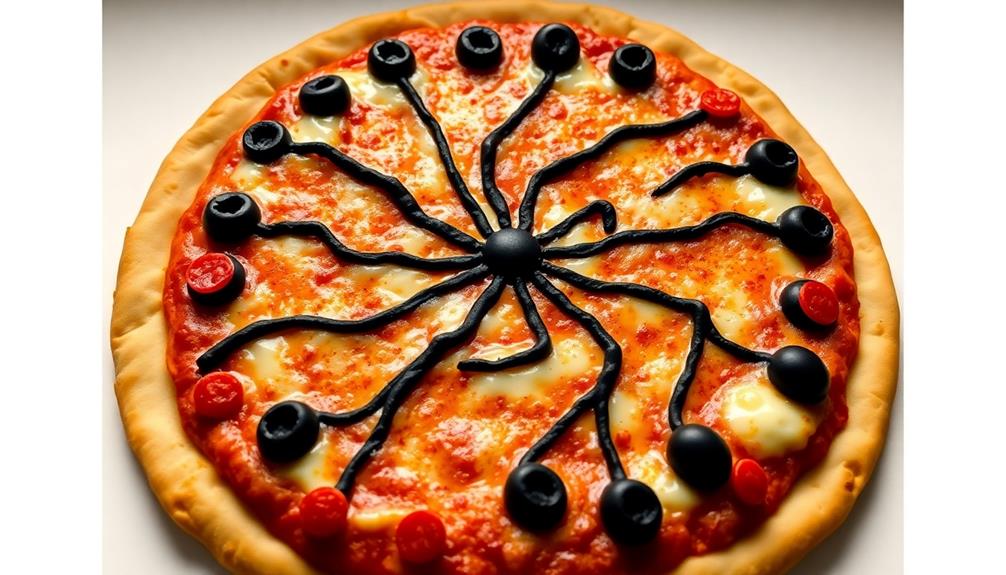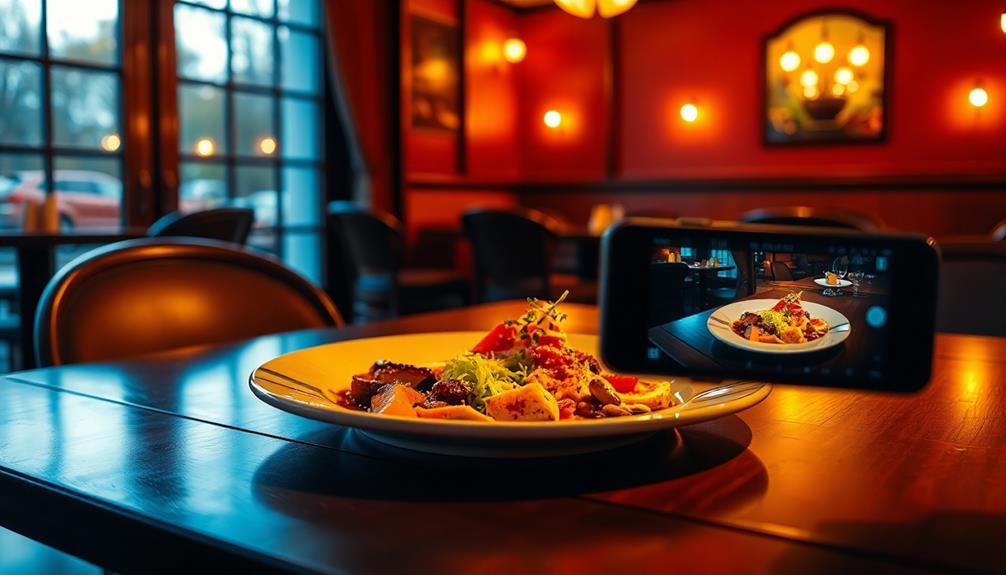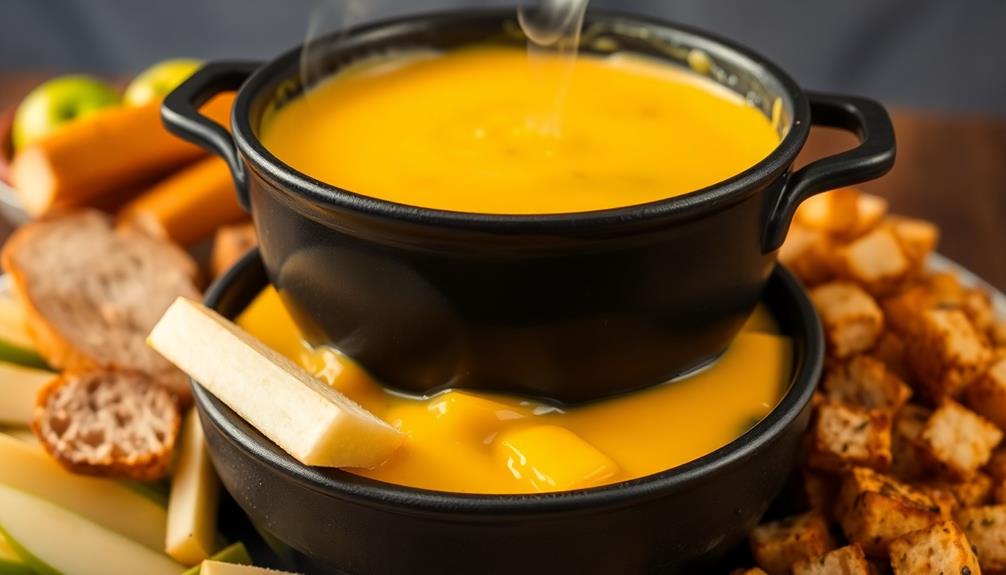Austin Butler's journey with voice coach Irene Bartlett transformed his portrayal of Elvis Presley. You'll find he focused on authenticity, shaping his unique vocal identity rather than mere imitation. Intensive training during the COVID-19 pandemic allowed him to fully immerse himself in both voice and character. This deep emotional connection greatly enhanced his performances, making Elvis's essence a part of him. Public reactions to his voice change demonstrated its impact on his identity and career. As Butler continues to evolve, the implications of his vocal journey are fascinating. There's so much more to discover about his inspiring transformation!
Key Takeaways
- Austin Butler underwent extensive voice coaching to authentically embody Elvis Presley, focusing on emotional connection and vocal identity.
- His training included immersive research, studying films and audio interviews to internalize Elvis's voice and mannerisms.
- The COVID-19 pandemic provided dedicated time for concentrated voice practice, leading to significant transformations in his vocal quality.
- Voice coaching emphasized authenticity over impersonation, shaping Butler's long-term vocal identity and impacting his acting career.
- Positive public reception and critical acclaim, including a Golden Globe win, highlighted the success of Butler's voice transformation journey.
Overview of Austin Butler's Role
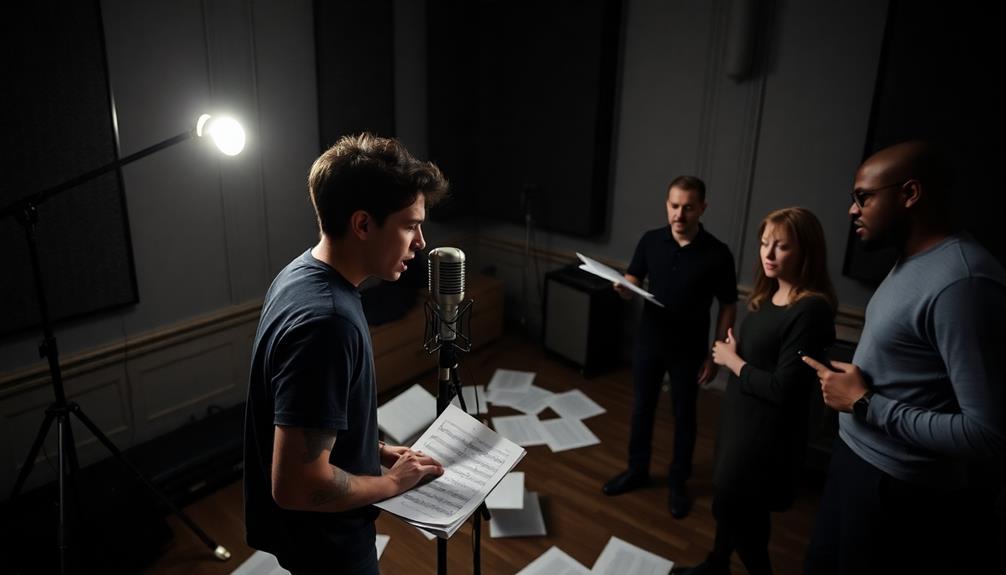
Austin Butler took on the monumental role of Elvis Presley in Baz Luhrmann's 2022 biopic, bringing the iconic musician's life and legacy to the big screen. You might be surprised to learn how deeply Butler immersed himself in the character. He didn't just memorize lines; he dove into extensive research, watching films and listening to audio interviews to truly capture the essence of Elvis.
This dedication set him apart and earned him critical acclaim, including the Golden Globe Award for Best Actor in Motion Picture Drama. His transformation can be likened to how young tennis prodigies often showcase exceptional skills at a young age, indicating the level of commitment required for success.
As you watch Butler as Elvis, you can see not just an impersonation but a genuine connection to the legendary singer's story. His transformation extended beyond just acting; it involved a significant voice change, which was vital to embodying Elvis's unique sound.
His voice coach, Irene Bartlett, noted the remarkable evolution in Butler's vocal delivery, highlighting his commitment to authenticity. This meticulous preparation and deep respect for the role allowed Butler to honor Elvis's legacy, making his performance unforgettable.
You can't help but appreciate the hard work and passion that went into portraying such an iconic figure.
Importance of Voice Coaching

When you think about performance, authenticity is key, and voice coaching can help you achieve that genuine connection.
Techniques for voice transformation not only refine your skills but also shape your vocal identity in lasting ways. As you explore this journey, you'll see how dedicated coaching can elevate your craft to new heights.
Furthermore, personalized learning experiences in voice coaching can enhance your unique vocal qualities, fostering a deeper engagement with your craft through tailored approaches like Predictive Modeling in Educational Data Mining.
Authenticity in Performance
Authenticity in performance hinges on the ability to connect genuinely with a character, and voice coaching plays an essential role in achieving that connection. For Austin Butler, working with voice coach Irene Bartlett was pivotal in embodying Elvis Presley.
Quotes to live by often emphasize the importance of resilience and dedication, qualities essential in an actor's journey. Here's why authenticity is vital in performance:
- Character Connection: A genuine portrayal requires understanding the character's emotions and background. Voice coaching helps actors explore these depths, allowing for a more immersive experience.
- Natural Voice Development: Butler's transformation wasn't just about mimicking Elvis; it was about developing a voice that felt real. This authenticity resonated with audiences and critics alike, showcasing his dedication to the craft.
- Enhanced Performance: Engaging in voice training not only refines vocal techniques but also reinforces an actor's confidence. This confidence translates into a more believable performance, making it easier for audiences to connect.
As Butler demonstrated, the journey to authenticity involves hard work and commitment.
Voice coaching isn't merely a tool for show; it's an integral process that shapes an actor's ability to deliver a genuine and enthralling performance.
Voice Transformation Techniques
Voice transformation techniques are essential for actors aiming to embody their characters fully. When you work with a voice coach, like Austin Butler did with Irene Bartlett, you focus on authenticity rather than mere imitation. This approach allows you to connect deeply with the persona you're portraying.
The time Butler dedicated to voice coaching during the COVID-19 pandemic led to significant changes in his vocal quality, showcasing the power of concentrated practice. Incorporating elements of the Law of Attraction in Sports and Fitness can enhance an actor's mindset, helping them visualize their success and maintain high vibrational energy throughout their training.
Bartlett designed techniques that enhanced Butler's natural singing voice, ensuring the transformation felt genuine rather than superficial. Immersive research—watching films and listening to interviews—helped Butler internalize Elvis Presley's voice and mannerisms, making the voice change a part of his "DNA."
This kind of voice transformation creates a deeper emotional connection to the character, making performances more compelling. While there's some uncertainty about the permanence of Butler's transformation, the process certainly left a lasting impact on his vocal expression.
Lasting Impact on Identity
There's no denying that voice coaching can profoundly shape an actor's identity, as seen in Austin Butler's remarkable transformation while preparing to portray Elvis Presley. His extensive work with voice coach Irene Bartlett not only altered his vocal skills but also intertwined his identity with that of Elvis.
This journey highlights the importance of voice coaching in several key ways:
- Emotional Connection: Butler's transformation involved a deep emotional connection to Elvis's story, making his portrayal authentic rather than merely mimicking the legend.
- Sustained Change: The immersive three-year preparation led to a voice that Butler described as part of his "DNA," suggesting that the impact of voice coaching extends beyond the role itself.
- Public Perception: The ongoing scrutiny of Butler's voice adaptation shapes how audiences perceive him, influencing future roles and his identity as an actor.
As Butler's acceptance speech at the Golden Globes demonstrated, the lasting changes in his voice signal a broader transformation in his identity.
The role of a voice coach, consequently, transcends mere technique; it cultivates an actor's authentic self, reshaping their professional journey.
Irene Bartlett's Coaching Techniques

Irene Bartlett's coaching techniques focus on fostering a genuine emotional connection in performers. As Austin Butler's voice coach, she emphasized the importance of authenticity while portraying Elvis Presley. Rather than encouraging mere impersonation, she guided Butler to tap into the emotional depth of the character, allowing him to connect with the essence of Elvis. This approach mirrors the growing trend in the beauty and grooming industry, where personalization and authenticity are key, as seen in the rise of clean beauty preferences among consumers.
During the COVID shutdowns, Butler dedicated significant time to his vocal training, fully immersing himself in the process. Bartlett's approach was designed to enhance Butler's natural singing voice, steering clear of performance-based mimicry. She believed that true artistry comes from within, and her techniques aimed to bring out Butler's unique vocal qualities.
Bartlett noted that Butler's voice change reflected this deep immersion, comparing it to a transformation that becomes part of his "DNA." While the extensive training led to significant alterations in his voice, she acknowledged that there's no definitive timeline regarding their permanence.
Through her coaching, Butler not only developed his vocal skills but also forged a deeper connection with the character he was embodying, ultimately achieving a more authentic representation of Elvis.
The Impact of COVID-19

Throughout the COVID-19 pandemic, Austin Butler found himself with an unprecedented opportunity to dive deeply into voice training, thanks to halted filming schedules.
With more time on his hands, he engaged intensively with his voice coach, Irene Bartlett, allowing for a remarkable transformation.
During this isolating period, Butler's dedication to his craft led to significant changes in his vocal quality.
Here are three key impacts of the pandemic on his voice training:
- Immersive Character Study: The lockdown allowed Butler to fully immerse himself in the character of Elvis Presley, integrating the role into his daily life and voice.
- Intensive Practice: With filming paused, he could focus extensively on voice work, gaining skills that went beyond performance needs.
- Personal Connection: Butler described the voice change as part of his "DNA," showcasing the profound impact this immersive experience had on him.
This deep connection to his character during COVID-19 has sparked ongoing public interest in the permanence of his transformed voice, leaving many wondering about the lasting effects of his dedicated training.
Transformation of Butler's Voice

When you think about Austin Butler's transformation, it's clear that his work with voice coach Irene Bartlett played an essential role in shaping his sound.
His immersive research process not only helped him connect authentically with Elvis but also sparked noticeable public reactions, especially during events like the Golden Globes.
You can see how deeply he internalized the character, drawing parallels to how people adapt their accents after living in a new culture.
Voice Coach Insights
Austin Butler's voice transformation is a fascinating journey shaped by the expert guidance of his coach, Irene Bartlett. Rather than focusing on mere impersonation of Elvis Presley, Bartlett emphasized authenticity and a genuine connection to the character. This approach made a considerable impact on Butler's vocal quality during the unique opportunity presented by the COVID shutdowns for extensive training.
Here are three key insights from Butler's voice coach:
- Natural Evolution: The techniques used in Butler's training weren't for show; they facilitated a natural evolution in his singing voice, enhancing his portrayal of Elvis.
- Deep Integration: Bartlett described Butler's transformation as becoming part of his "DNA," indicating a profound integration of Elvis's essence into his vocal expression.
- Lasting Impact: While there's no definitive timeline for how long the voice change will last, the immersive experience of the role could considerably influence Butler's vocal identity moving forward.
Through this collaboration with his voice coach, Butler's voice transformation not only reshaped his vocal abilities but also deepened his connection to the character he portrayed.
Immersive Research Process
A thorough approach defined Austin Butler's immersive research process for portraying Elvis Presley, blending extensive study with practical application. You'd find him watching films and listening to audio interviews, all to capture the essence of Elvis's voice and personality. This process was akin to living in a foreign country, where he aimed to deeply understand not just the music, but the cultural impact Elvis had on the world.
His voice coach, Irene Bartlett, emphasized that their training wasn't about mere imitation; it was about forming a genuine connection to Elvis's natural singing voice.
During the COVID-19 pandemic, Butler had the rare opportunity to focus intensely on voice development, which led to significant transformations in his vocal quality. You could see how deeply he integrated Elvis's vocal characteristics into his own voice.
Bartlett noted that this transformation became part of Butler's "DNA," showcasing how thoroughly he absorbed and embodied the essence of the legendary singer. This immersive research process ultimately shaped not just his performance, but his entire approach to bringing Elvis to life on screen.
Public Reactions Observed
Butler's extensive preparation for the role of Elvis Presley sparked significant public intrigue, especially regarding his voice transformation. His acceptance speech at the Golden Globes showcased a drawl that many found reminiscent of Elvis, prompting discussions about the authenticity of his transformed voice. You might've noticed how this shift captivated audiences and generated mixed reactions.
Here are three key observations about the public's response:
- Authenticity Questions: Viewers questioned whether Butler's voice change was genuine or simply an act, drawing parallels to individuals who adapt their accents after living abroad.
- Positive Praise: Priscilla Presley praised Butler's vocal performance, which further solidified the public's favorable reception of his Elvis-like voice.
- Media Spotlight: Major media outlets extensively covered Butler's voice post-acceptance speech, highlighting the significant interest in how his work with a voice coach affected his vocal identity.
Backstage, Butler acknowledged the buzz surrounding his voice change, revealing the depth of public fascination with his portrayal of Elvis.
This response illustrates how transformative roles can extend beyond performance, prompting discussions about identity and authenticity.
Audience and Media Reactions
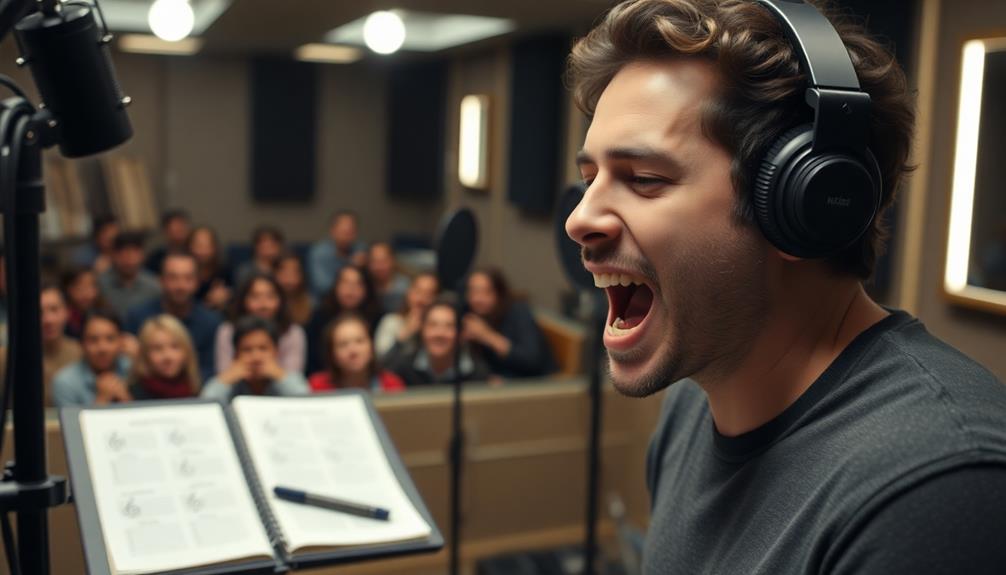
During his Golden Globe acceptance speech, many noticed Austin Butler's Elvis-like drawl, sparking a flurry of discussions about the authenticity of his voice transformation.
Media outlets like Access Hollywood highlighted how captivated the public is by Butler's dedication to embodying Elvis Presley in Baz Luhrmann's film. This fascination led to conversations about whether his altered voice represents a lasting change or merely a temporary adaptation.
Backstage, Butler acknowledged the ongoing chatter surrounding his vocal shifts, showing he's aware of how public perception impacts his performance.
While some critics and audience members praised his vocal dedication, others expressed mixed feelings about its authenticity. They questioned if his drawl is an ingrained part of his identity now or a phase linked to his role.
Adding to the positive media narrative, Priscilla Presley herself praised Butler's vocal performance, further solidifying the admiration for his portrayal of Elvis.
Long-Term Career Implications

As you consider the long-term implications of Austin Butler's voice transformation, you'll notice the challenges he may face in adapting to roles that require different vocal styles.
This change could reshape his career evolution, both expanding his opportunities and presenting new hurdles.
You'll want to think about how these factors will influence his future choices and public perception as he navigates the evolving landscape of Hollywood.
Voice Adaptation Challenges
Austin Butler's journey through extensive voice coaching for his role as Elvis Presley presents intriguing voice adaptation challenges that could considerably impact his long-term career.
His significant voice transformation raises questions about how this new vocal quality will influence his future roles.
Here are three key challenges you might consider:
- Character Consistency: As Butler takes on diverse characters, he may need to adapt his voice, which could be challenging if the Elvis-like drawl lingers.
- Public Perception: Critics and audiences are curious about whether his transformed voice reflects a genuine part of his identity or if it's an adaptation that will fade over time.
- Vocal Health: The extensive techniques used by his voice coach, Irene Bartlett, aimed for authenticity but could have long-term implications for his vocal health if not managed correctly.
As Butler navigates these voice adaptation challenges, he must balance his newfound vocal identity with the versatility required for a successful acting career.
The impact of this voice transformation could shape not only his performances but also how he's perceived in the industry moving forward.
Career Evolution Possibilities
Butler's voice transformation not only poses immediate challenges but also opens up various possibilities for his career evolution.
As Austin Butler navigates his post-Elvis journey, the extensive work he did with his voice coach during the pandemic has altered his vocal identity, positioning him for new and diverse roles. His Golden Globe win for Best Actor has made him a highly sought-after talent, which could lead to exciting opportunities across different genres.
However, the public's fascination with his vocal change might also bring the risk of typecasting. You might see him primarily cast in roles that require a similar vocal style or persona, potentially limiting his range.
Yet, this transformation could also encourage Butler to explore characters that push his boundaries, adapting his acting technique to fit new narratives.
Long-term, the effects of his voice change could shape how audiences and industry professionals perceive him.
With careful navigation, Austin Butler can leverage this unique aspect of his career to evolve and redefine his roles in Hollywood, ensuring that he remains a versatile and compelling actor for years to come. This journey will require deliberate choices that showcase his depth and range, allowing him to step beyond the shadows of earlier portrayals and establish a lasting legacy. By thoughtfully selecting projects that challenge him creatively, Austin Butler can further solidify his reputation as an artist dedicated to his craft. Whether through thought-provoking roles or the public intrigue surrounding Austin Butler and Kaia Gerber, he has the opportunity to keep audiences captivated both on and off the screen.
Personal Reflections From Butler

Immersing himself in the world of Elvis Presley, Butler found a profound connection to the music that shaped his portrayal of the iconic figure. He compared his love for Elvis's songs to the difficulty of choosing a favorite child, illustrating the depth of his appreciation. This connection transcended mere performance; it became a part of his identity.
Butler recently took a long-overdue vacation in Mexico, his first in over a year, highlighting the necessity of breaks in a demanding career. He actively participated in Elvis's birthday celebration, reinforcing his ongoing bond with the character and the legacy he portrayed under Baz Luhrmann's direction.
Here are three reflections that resonate with him:
- Emotional Connection: Music has the power to evoke feelings and memories that shape who you are.
- Importance of Balance: Taking breaks is essential for creativity and mental well-being.
- Celebration of Achievements: Recognizing milestones, like winning the Golden Globe, fuels passion and gratitude.
Butler's journey embodies a profound respect for Elvis's artistry and the personal growth that comes from such an immersive experience.
Insights From Voice Coaching Sessions

During his transformative journey to embody Elvis Presley, Austin Butler engaged in intensive voice coaching that played a crucial role in shaping his performance. His voice coach, Irene Bartlett, prioritized authenticity, encouraging him to forge a genuine connection with the character rather than simply imitating Elvis. This approach allowed Butler to develop an Elvis-like drawl, which even emerged during his Golden Globe acceptance speech.
The extended training sessions made possible by the COVID-19 pandemic provided Butler with ample time to refine his vocal skills. Bartlett highlighted that the techniques used weren't just for show; they reflected a significant transformation that became integral to Butler's vocal identity.
His extensive research and immersion in Elvis's life and music were akin to living in a foreign country, deeply influencing his vocal delivery.
While the long-term permanence of Butler's voice change remains uncertain, Bartlett believes the experience could have lasting effects on his vocal abilities. Ultimately, through dedicated coaching and a focus on authenticity, Butler's journey with his voice coach paved the way for a deeply resonant performance that honored the legendary artist.
Future Directions for Butler's Career
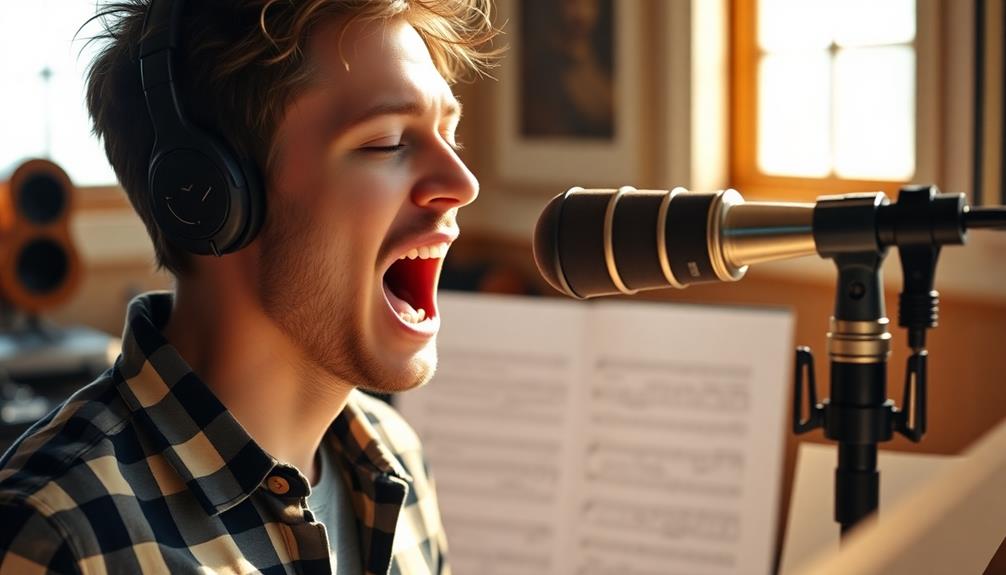
There's no doubt that Austin Butler's portrayal of Elvis Presley has opened new doors for his career, leading to both critical acclaim and a Golden Globe win. As he navigates this pivotal moment, you can expect to see several exciting directions for Butler's future:
- Diverse Roles: With his voice transformation from working with his voice coach, Irene Bartlett, Butler may explore characters that challenge his vocal range, allowing him to showcase his versatility.
- Theatrical Projects: Given his dedication to the arts, it wouldn't be surprising if he ventured into stage performances, where his vocal skills can shine in a live setting.
- Continued Collaboration: Butler might continue to work with his voice coach to refine his craft, adapting his vocal identity to fit various roles while maintaining the essence of his Elvis portrayal.
As Butler moves forward from the shadow of Elvis, public scrutiny will likely influence his acting choices.
The long-term effects of his voice change remain uncertain, but one thing's clear: Austin Butler's journey is just beginning, and his commitment to growth will shape his career in thrilling ways.
Frequently Asked Questions
Did Austin Butler Take Singing Lessons?
Yes, you can say Austin Butler took singing lessons. He worked closely with a voice coach to develop his vocal skills, ensuring he could authentically portray the character he was meant to embody in the film.
Did Austin Butler Use His Own Voice?
When you listen closely, you might think Austin Butler's voice is his own, but he worked hard to evoke Elvis's essence. His transformation involved deep immersion, blending genuine talent with extensive coaching for authenticity.
Who Is the Voice Coach in Austin Butler?
If you're wondering about the voice coach in Austin Butler's journey, it's Irene Bartlett. She guided him in developing an authentic vocal portrayal, emphasizing genuine connection over impersonation for his role as Elvis Presley.
Where Did Austin Butler Get His Start?
You might think Austin Butler burst onto the scene like a shooting star, but he actually started on Nickelodeon's "Ned's Declassified School Survival Guide," laying the groundwork for his impressive acting career in Hollywood.
Conclusion
Austin Butler's journey with a voice coach has been nothing short of transformative. With each note and nuance, he's sculpted his vocal identity, preparing for a future where his voice sings louder than ever. Just like a butterfly emerging from its cocoon, Butler's dedication has paved the way for a vibrant career ahead. As he steps into new roles, his commitment to his craft guarantees that the world will hear his story, one powerful performance at a time.
